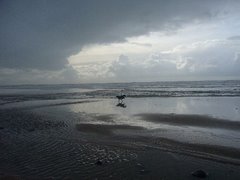
In a previous post I wrote about Bonzo, the Broholmer and promised to write about the breed.
This breed dates back to the late 16th century. The daughter of the Danish King Frederik II married the Scottish King James VI in 1589. King James gave some English mastiff-like dogs as a present to the Danish court. These dogs were mated with local dogs - resulting in what today is regarded as the start of the Broholmer-breed: The Old Danish Dog.
They were big and were used for stag and big game hunting. This type of hunting was banned in 1777 and hence the need for such big hunting dogs disappeared. They were then used as guard dogs on large farms and manors. Slowly the interest in this type of dog declined and the breed became almost extinct. In 1850 a nobleman called Niels Frederik Bernhard Sehested to Broholm Manor on Funen revived the breed and it is from him the breed inherited its name. But the breed lost ground again at the beginning of the 20th century because of the two World Wars, distemper, epidemics and in-breeding.
At the end of the 1970s, the Danish Kennel Club organized a nationwide seach for the Broholmer through an extended advertising campaign. This is how the Broholmer Society was started and by the end of the 1990s, the breed was accepted by the FCI.
To own a Broholmer you must be a member of the Broholmer Society and you must sign an agreement in which you agree to let your dog participate in the breeding program. The dog has to pass the required tests ( X-ray of elbows and hips to detect HD, tests to ascertain mental stability and compliance to the FCI breed standard) before being accepted for breeding.
PS: the dog on the picture is Bonzo.














